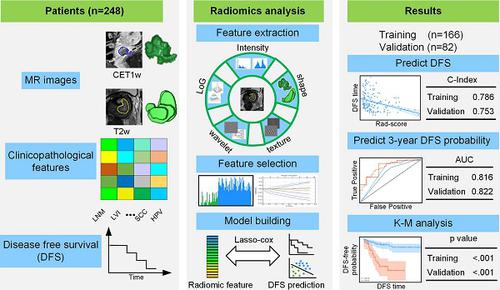Theranostics ( IF 12.4 ) Pub Date : 2020-01-01 , DOI: 10.7150/thno.37429 Jin Fang 1 , Bin Zhang 1 , Shuo Wang 2, 3 , Yan Jin 4 , Fei Wang 1 , Yingying Ding 4 , Qiuying Chen 1 , Liting Chen 1 , Yueyue Li 1 , Minmin Li 1 , Zhuozhi Chen 1 , Lizhi Liu 5 , Zhenyu Liu 3, 6 , Jie Tian 2, 3, 6 , Shuixing Zhang 1

|
Pre-treatment survival prediction plays a key role in many diseases. We aimed to determine the prognostic value of pre-treatment Magnetic Resonance Imaging (MRI) based radiomic score for disease-free survival (DFS) in patients with early-stage (IB-IIA) cervical cancer.
Methods: A total of 248 patients with early-stage cervical cancer underwent radical hysterectomy were included from two institutions between January 1, 2011 and December 31, 2017, whose MR imaging data, clinicopathological data and DFS data were collected. Patients data were randomly divided into the training cohort (n = 166) and the validation cohort (n=82). Radiomic features were extracted from the pre-treatment T2-weighted (T2w) and contrast-enhanced T1-weighted (CET1w) MR imagings for each patient. Least absolute shrinkage and selection operator (LASSO) regression and Cox proportional hazard model were applied to construct radiomic score (Rad-score). According to the cutoff of Rad-score, patients were divided into low- and high- risk groups. Pearson's correlation and Kaplan-Meier analysis were used to evaluate the association of Rad-score with DFS. A combined model incorporating Rad-score, lymph node metastasis (LNM) and lymphovascular space invasion (LVI) by multivariate Cox proportional hazard model was constructed to estimate DFS individually.
Results: Higher Rad-scores were significantly associated with worse DFS in the training and validation cohorts (P<0.001 and P=0.011, respectively). The Rad-score demonstrated better prognostic performance in estimating DFS (C-index, 0.753; 95% CI: 0.696-0.805) than the clinicopathological features (C-index, 0.632; 95% CI: 0.567-0.700). However, the combined model showed no significant improvement (C-index, 0.714; 95%CI: 0.642-0.784).
Conclusion: The results demonstrated that MRI-derived Rad-score can be used as a prognostic biomarker for patients with early-stage (IB-IIA) cervical cancer, which can facilitate clinical decision-making.
中文翻译:

MRI放射生物标记物与早期宫颈癌患者的无病生存率相关。
治疗前生存期预测在许多疾病中都起着关键作用。我们旨在确定基于磁共振成像(MRI)的放射学评分对早期(IB-IIA)宫颈癌患者的无病生存(DFS)的预后价值。
方法:在2011年1月1日至2017年12月31日期间,共有两家机构纳入了248例行宫颈癌根治术的早期宫颈癌患者,收集了其MR影像数据,临床病理数据和DFS数据。将患者数据随机分为训练队列(n = 166)和验证队列(n = 82)。从每个患者的治疗前T2加权(T2w)和对比增强的T1加权(CET1w)MR影像中提取放射特征。应用最小绝对收缩和选择算子(LASSO)回归和Cox比例风险模型构建放射学评分(Rad评分)。根据Rad评分的临界值,将患者分为低风险和高风险组。皮尔逊相关性和Kaplan-Meier分析用于评估Rad得分与DFS的关联。
结果:在训练和验证队列中,较高的Rad评分与较差的DFS显着相关(分别为P <0.001和P = 0.011)。与临床病理特征(C指数,0.632; 95%CI:0.567-0.700)相比,Rad评分在估计DFS(C指数,0.753; 95%CI:0.696-0.805)方面显示出更好的预后性能。但是,组合模型未显示任何显着改善(C指数,0.714; 95%CI:0.642-0.784)。
结论:结果表明,MRI衍生的Rad评分可作为早期(IB-IIA)子宫颈癌患者的预后生物标志物,有助于临床决策。











































 京公网安备 11010802027423号
京公网安备 11010802027423号